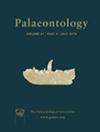我相信我能飞......基于晚三叠世 Ozimek volans 独特的长骨组织学对其生活方式和古生态学的新启示
IF 2.3
2区 地球科学
Q1 PALEONTOLOGY
引用次数: 0
摘要
小型无脊椎爬行动物 Ozimek volans 是波兰克拉谢茹夫晚三叠世动物群中最神秘的代表之一。在系统发育上,Ozimek 被确定为与澹龙类有关的 "原龙类",但其极度伸长的四肢和假定的滑翔能力在该类动物中并不常见。这就提出了一个问题,即推断出的该类群的生活方式是否反映在其骨骼组织学中。为了获得组织学框架的细节,我们对来自奥齐梅克单个骨群的两块长骨(肱骨 UOPB 1148a 和股骨 UOPB 1148b)进行了中轴切片。两块骨头都有一个大的髓腔,薄壁的片状骨中有许多片状骨,只有极少数简单的血管管。奥齐梅克四肢骨直径小、结构紧凑、血管化程度低、无重塑和缺乏气孔,在组织学上与现代小型蝙蝠的四肢骨相似。两者特有的皮质可能都非常适合承受高负荷,同时限制重量。骨骼上连续层状的胶原纤维排列有序,这可能是滑翔过程中更好地分配产生的负荷的关键适应因素。© 2024 古生物学会。本文章由计算机程序翻译,如有差异,请以英文原文为准。
I believe I can fly… New implications for the mode of life and palaeoecology of the Late Triassic Ozimek volans based on its unique long bone histology
The small diapsid reptile Ozimek volans is one of the most enigmatic representatives of the Late Triassic fauna of Krasiejów, Poland. Phylogenetically, Ozimek was identified as a ‘protorosaurian’ related to tanystropheids, but the extremely elongated limbs and presumed gliding abilities are unusual for this group. This raises the question of whether the lifestyle inferred for this taxon is reflected in its bone histology.Two long bones from a single bone association of Ozimek (humerus UOPB 1148a and femur UOPB 1148b) were sectioned at the midshaft to obtain details of the histological framework. A large medullary cavity, thin walls of lamellar bone with numerous lamellae, and only very few simple vascular canals are shared by both bones. Application of a modified 3‐front model (introducing a fourth front) of cortical growth reveals that the femur is ontogenetically younger when compared to the humerus.Ozimek limb bones, with their small diameter, compact structure, low vascularization, no remodelling, and a lack of pneumaticity, are histologically similar to those of modern small bats. The characteristic cortex of both may have been well suited to withstand high loads while limiting weight. The well‐ordered collagen fibres in successive lamellae along the bone may be a key adaptation for the better distribution of the load generated during gliding. © 2024 The Palaeontological Association.
求助全文
通过发布文献求助,成功后即可免费获取论文全文。
去求助
来源期刊

Palaeontology
地学-古生物学
CiteScore
5.60
自引率
3.80%
发文量
43
审稿时长
6 months
期刊介绍:
Palaeontology publishes a wide variety of papers on palaeontological topics covering:
palaeozoology
palaeobotany
systematic studies
palaeoecology
micropalaeontology
palaeobiogeography
functional morphology
stratigraphy
taxonomy
taphonomy
palaeoenvironmental reconstruction
palaeoclimate analysis and biomineralization studies.
 求助内容:
求助内容: 应助结果提醒方式:
应助结果提醒方式:


